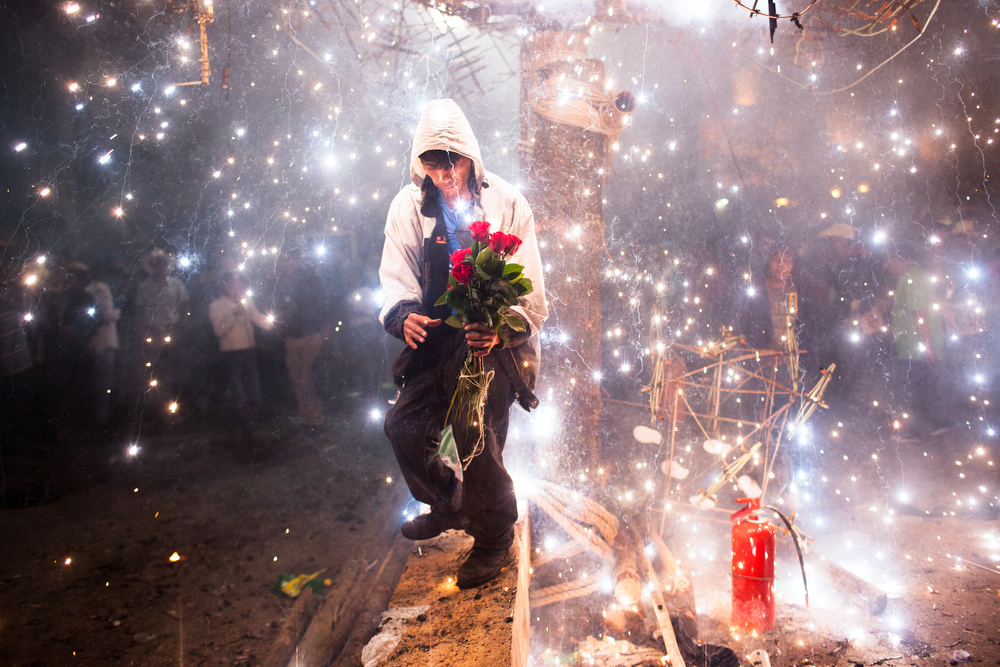Vice Media and the Magnum Foundation are heavy hitters in photojournalism. In a world now inundated with smartphone snapshots, these two institutions continually produce and hone true professional talent. They champion work that’s visually arresting and indicative of a larger context, with a complex narrative that lurks beyond the frame. However, at last week’s partnered exhibition, “The New Photojournalism,” Vice and Magnum’s usual effect was lost in the shuffle at Angell Gallery when displayed on real walls.
The exhibition, which has moved to Montreal’s Phi Centre and will be on view there until July 31, amounted to a brick-and-mortar translation of the print magazine’s annual Photo Issue. It was co-curated by award-winning Magnum photographer Larry Towell and features international photographers Mauricio Palos, Dominic Nahr, Aaron Vincent Elkaim and Brett Gundlock. There was also a slideshow of Zun Lee’s photographs on a television screen in the gallery entrance. Towell said that he chose works that spoke to each other and the conversation that ensued centred on violence and isolation.
From Palos’s photograph of a severed head in Acapulco to Nahr’s portraits of Iraqi refugees, the images told stories of displacement. An added layer of journalistic aloofness further fed that theme. The most successful photographs documented subjects with a blunt accuracy that superseded artistic vision and aesthetics. The photographers all possess individual voices, but issues of style are second to facts.
Presented in the magazine, each image is glossy yet poignant, paced one image at a time in a building narrative framework. This is how we usually see photojournalism, and the magazine experience did not translate successfully in the gallery. The framed photographs, sized approximately to the same dimensions as the magazine, were hung tightly together. They had no room to breathe. Many of the images, like Brett Gundlock’s Mexican firework fiesta photograph, which headlined promotional materials for the show, begged to be larger. In an isolated area of the gallery, Elkaim’s Sleeping with the Devil series took on the air of a solo exhibition. The series, which documents Fort McKay and the socio-environmental impacts of oil-sand development, was a well executed and a much-needed change of pace. With its room for engagement, Elkaim’s series felt like the show that Vice and Magnum could have created.
The panel discussion held in conjunction with the exhibition’s Toronto opening added insight to the gallery show. The subject was the evolving field of photojournalism and a delightfully cranky Towell announced that he didn’t like being on panels and doesn’t know anything about social media. He proceeded to tell campfire stories about a storied time when publications would give out fat cash advances for photographers to develop a photo series.
Elkaim and Lee, part of a younger generation, explained that social media can be a useful tool for connecting to audiences and that photographers occasionally have to accept off-brand work to fund personal projects. It’s a different photojournalistic world for Elkaim and Lee, but they accept the reality of their situation and look for new ways to make it work. Instagram’s director of brand development, Daniel Habashi, was roasted for his connection to a company that helps facilitate a world cluttered with mediocre images. When Lee described his series Father Figure, an intimate collection of images that challenge the stereotype of black men as irresponsible fathers, the alternative was fully present. Abstract notions of “what photography means” and squabbles about Instagram were replaced by a concrete example of what important work looks like. It made you want to leave your seat and find Lee’s photographs in the exhibit, crowded as it was.









